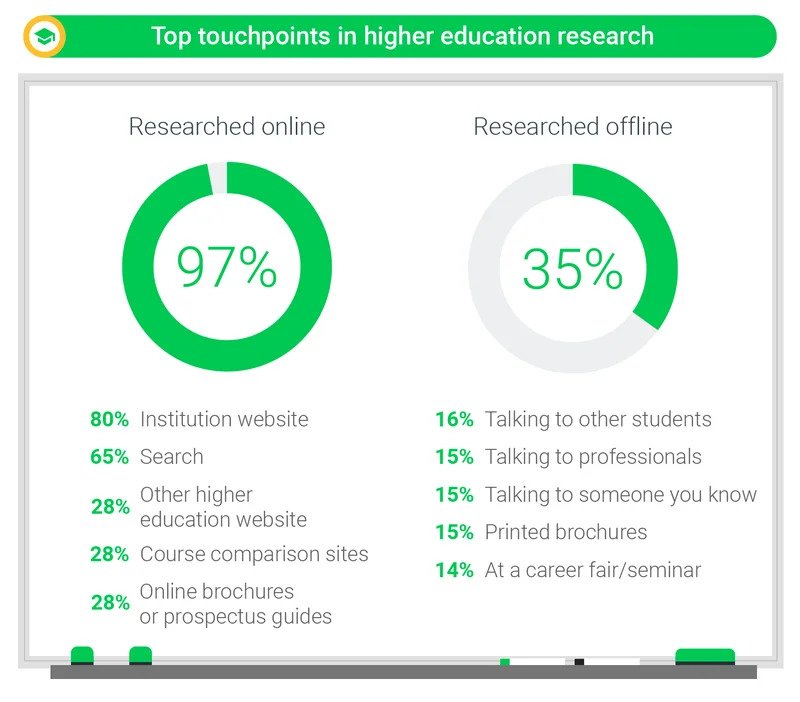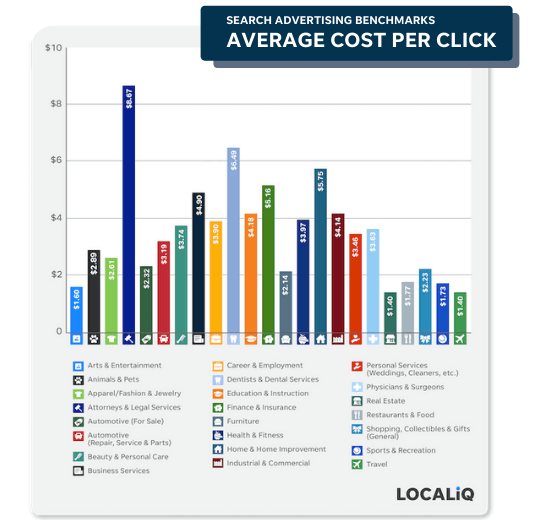

Choosing a higher education institution is a pivotal decision, and a growing number of students in the US are starting to research their options months—sometimes years—before enrolling. Every time prospective students go online to research, higher education marketers have a massive opportunity to show up with relevant digital content and help them make a well-informed decision.
Finding the right institution used to involve campus visits and flipping through stacks of brochures, but students today increasingly choose to spend their time researching online, bouncing between devices. In fact, 97% of students in a study done by Google researched their options online. Search was a crucial resource for most of these students, with 65% using a search engine at some point during their path to purchase.

Interestingly, students were more certain about their choice of coursework than about their choice of institution when they started their research—72% of students started with a specific course in mind, while only 36% were sure of their provider of choice. When they’re ready to learn about an institution, students get the bulk of their information from providers’ websites. A site full of helpful information is paramount, but an institution’s search performance is still a top factor: 45% of prospective students reported that they have a better opinion of universities that appear on the first page of search results.
Your higher education institution might offer excellent study programs, with some of the best professors in the field and superb facilities to accommodate students. But, if the school’s site doesn’t appear in the first few rankings of relevant search results, it’s less likely that students will ever see it while searching for suitable programs and, therefore, not be aware of all you have to offer.
Google is by far the dominant search engine, with an impressive 87.72% of all searches in the U.S. happening on it. So, higher education institutions can significantly benefit from the increased visibility of their website in Google searches by employing the proper Search Engine Optimization (SEO) strategies.
From targeting the right keywords to optimizing your website’s on-page elements, by using SEO as a marketing channel, you can increase the quantity and quality of leads and applications coming from your website.
Organic search (SEO) has the second highest lead to application to student conversion rate, beaten only by Direct traffic, and it’s way ahead of other channels like Paid Search, Social, and others.
So, read on and learn more about how you can grow college enrollment with SEO for higher education, or directly take action and contact our agency that specializes in higher education SEO services.
There are currently 4,360 higher ed. institutions in the U.S., so this is undoubtedly a fiercely competitive market. Most are familiar with Google Ads and spend hundreds of thousands to millions of dollars on it yearly. The education vertical is one of the biggest spenders in Google Ads.

Yet, SEO which allows you to rank organically without the need to pay for every click, has a better ROI, and is more sustainable as a marketing strategy, is left out when the budgets are decided.
This could be your secret weapon.
The cost to show your ads for specific keywords has increased year over year, and the competition is brutal, but the same can’t be said about SEO. Over 70% of the clicks that happen on search results go to organic results, and only a few higher ed. institutions are capitalizing on it.
The goal is to rank for relevant keywords. This way, when students search these keywords, they will quickly come across your institution. The organic position of your site will help you expand your reach, resulting in more qualified traffic where students visiting your site are more likely to enroll in your programs.
Another benefit of using SEO as a marketing channel for your higher education institution is that it can help you improve the brand’s credibility. Typically, a higher search ranking is associated with credibility, as people are more likely to trust the first few results listed to provide the correct information.
In a chain reaction, the improved ranking that offers more credibility is then responsible for more qualified traffic, as reports show that the first organic result in Google Search has an average click-through rate of 43.32%. In addition, the second and third results have a 37.36% and 29.9% click-through rate, respectively. Therefore, SEO will not only help your site rank higher but, as a result, also make it a more trustworthy and reputable source, thus increasing student enrollment.
Throughout the following sections, we will go into more detail about some SEO enrollment strategies where we tackle keywords, on-page SEO elements, mobile performance, website speed, and the content provided.
Keywords are a group of words people use in the search bar for information and are a fundamental part of SEO. By conducting keyword research, you can find out what terms people are actively searching for and how competitive each keyword is. You can then use the data gathered for marketing plans to increase your site’s organic traffic and ranking.
Before determining your content’s keywords, you must first identify your target audience via market research and your students’ insights. This way, you can pinpoint potential students’ needs, behaviors, and concerns and therefore consider what questions they might have regarding college and study programs so you can direct your keyword research toward the information they need.
Once you identify the keywords related to your services, you have also determined what the searchers want and, therefore, can focus your content on those topics to meet their wishes. The more instances of a keyword used in your content and meta tags, the higher the potential for better search ranking and improved visibility. But if you ignore keywords or use the wrong ones, you will not get the visitors you want because your content does not match what the audience is searching for.
Typically, keyword research tools identify the keyword’s monthly search volume and difficulty level. When choosing the keywords, you’ll want to find keywords that have a high monthly search volume but are also easy to use and have less competition.
The most important thing to remember when choosing keywords is understanding the search intent behind that keyword. When that is understood correctly, you know with what type of content (program page, info page, location page, or blog post) you can target that keyword & have a shot at ranking.
On-page optimization refers to the SEO strategy that helps shape various structural elements of a website with the intention of increasing its search engine visibility and rankings. This strategy covers all internal aspects of a webpage, including the title tag, meta description, header tags, URLs, internal linking, and more, as they attempt to boost the page’s ranking.
Similar to what was previously discussed regarding keyword optimization, through on-page optimization, the implementation’s objective is to attract more qualified traffic through better visibility.
Your site can achieve such objectives through a series of actions. Firstly, update the title and description of pages/articles with relevant keywords and add necessary, creative, and engaging descriptions about the site and content integrated into it while maintaining a balanced ratio of targeted keywords used throughout them. Furthermore, it is best to structure the content using header tags that, once again, incorporate relevant keywords but also help present a better-organized page. Headers and subheaders offer the ideal areas to strategically include keywords without overstuffing the content.
Optimizing your site’s on-page content will help Google, and any other search engine gain context about the main topic and subtopics discussed on your page. This way, users can quickly determine that your site matches their search intent, click on it, and hopefully enroll at your college.
Though keywords and on-site optimization help provide more visibility to your site and therefore help your site reach wider audiences, the actual test of whether you generate qualified conversions depends on the content provided once they click on your site. In short, elevating your content strategy is vital to college enrollment.
In your quest to improve your content, there are a few things you can do. To begin, go back to the target audience we mentioned. Think about your audience, what they want, and what they are searching for online. Then, consider how your programs can benefit them and create content compelling them to take action.
Your site will attract prospective students by providing helpful information, as the right content strategy is your ticket to establishing a positive brand image. Furthermore, having a precise content strategy that is value-based as well as audience-focused and being consistent with it will result in people constantly coming back for more content from you. As a result of all this, your audience will see your site as a trustworthy and informative source, and when the time comes to convert, they’ll remember and come to you.
We’re seeing mobile become increasingly important to students’ research, particularly early in the process as students narrow their consideration sets. Higher education-related searches on mobile are on the rise, growing by 8% in 2017.2 And when an institution’s website or app wasn’t optimized for mobile, 36% of students said they’d be less likely to revisit it.
With more students choosing to research on mobile, it’s also crucial that marketers ensure that their websites and apps are optimized for a smooth, easy-to-navigate mobile experience and that attribution models are updated to accurately value mobile’s role in the path to enrollment.
Our experts point out that minimizing the use of plugins, leveraging caching, and image compression are some of the best practices that can help optimize your site’s page speed.
The benefits associated with page speed can be seen in one of our case studies. Before we started working with them, their site had several issues, including page speed. However, once we conducted our research, identified the problems, created the right strategies to deal with each one, and made the changes needed, the results were exceptional. Through similar approaches as the one provided above, we achieved a +550% increase in leads coming from SEO, a +2,500% increase in organic traffic, and an over $80k increase in monthly traffic value.
A sure proof of the success that can be achieved through SEO is our work together with Pacific College, which resulted in a 900% increase in organic leads.

Pacific College changed its CMS from WordPress to Squarespace in 2018. When this migration happened, many SEO best practices weren’t implemented, and the organic traffic dropped significantly.
They had a lot of deleted pages that used to drive tons of highly qualified organic traffic. These pages were deleted during the migration as the team managing this process wasn’t aware of their traffic contributions to the site.
Also, when the CMS changed, the URL structure changed as well. Program pages were the ones most affected by this. Important pages with a lot of backlinks weren’t migrated to the new Squarespace site, resulting in ‘link equity’ going to 404 pages instead.
They lacked content. A news section existed, and it was updated from time to time, but apart from that, there was no content strategy in place.
Conversion tracking wasn’t set up. Google Analytics was implemented, but it wasn’t tracking any type of conversions. Also, when the new Squarespace website was built, a new GA view with no historical data was created & implemented, resulting in fragmented data sources.
Missing pages:
We recreated and updated all the missing pages deleted during the migration. We did the same thing with broken pages that had backlinks. In just a few weeks, they started to drive a significant amount of qualified search traffic back to the site.
Broken internal links:
We fixed all broken internal links. We used this opportunity to audit all internal links, optimize anchor text on most of them, add new internal links on pages where we had this opportunity, and other optimizations.
Website speed:
We identified the areas slowing down the site and optimized those for better performance.
Conversion tracking:
We implemented best practices, and the data we were able to gather from tracking conversions helped us adjust and improve our overall SEO strategy.
Content strategy + implementation:
After we were done with the SEO audit, we dived deeper into understanding / analyzing the search landscape & our competitors. We found out that there is a lot of search demand around the degrees Pacific College offers, and very few institutions are talking about them.
We realized that there is a lot of potential in creating content around informational topics like “lvn vs rn” or “what does a nurse practitioner do”. These were potential students looking to educate themselves, and the pages that were ranking weren’t doing a great job of offering the best answer.
We had the expertise & it was in our niche, so we did an extensive keyword search, built a content calendar, and started publishing content regularly.
While students’ paths to enrollment have migrated almost entirely online, they still crave the knowledge gained by a real-life campus visit—and SEO is making it easier for schools to bridge that gap. As higher education options become more readily available, institutions can capture prospective students’ attention by showing up in search results with helpful, relevant content and creating a seamless experience for them as they bounce between devices to help inform one of the most important decisions of their lives.
Are you interested in witnessing firsthand all the benefits of a good SEO strategy? Contact us for a free SEO gap analysis to learn more about the potential of your site and all the opportunities we can provide you with. Begin your SEO journey and take the first step toward success!

CEO, Co-Founder
Faton is the Co-founder & CEO of Manaferra and someone who wakes up every morning seeing endless possibilities to progress and help others make a difference, for the better. That thought then translates everything he does to see both the team and clients move forward.
Faton is the Co-founder & CEO of Manaferra and someone who wakes up every morning seeing endless possibilities to progress and help others make a difference, for the better. That thought then translates everything he does to see both the team and clients move forward.
READ THE CASE STUDY